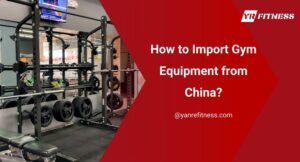Ever wonder why seated cable rows are considered a must-have exercise in back training? Because they target multiple muscle groups and improve overall strength and stability.y
As a gym equipment expert, I know that understanding the mechanics and benefits of this exercise can lead to better workout results.
Seated cable rows build a stronger back and also contribute to better posture and muscular balance. When performed correctly, they provide a range of benefits that can elevate any strength training routine.
In this guide, we will focus on mastering the seated cable row, learning proper techniques, and exploring variations to maximize gains. We will also discuss key safety tips and form corrections.
So let’s get into it!
Table of Contents
1. What is Seated Cable Row?
The seated cable row is an excellent exercise for developing the muscles in the back. The primary muscles engaged are the latissimus dorsi (or lats), which run along the sides of the back, and the rhomboids, which are located between the shoulder blades. By focusing on these muscles, anyone can build a stronger and more defined back profile, enhancing the overall upper-body physique.
Additionally, the seated cable row is a compound exercise that also targets secondary muscles, such as the biceps and forearms, which are engaged during the pulling motion. This combination makes it an efficient movement for training multiple muscle groups at once. The involvement of these smaller muscle groups not only supports the primary back muscles but also improves grip strength and arm endurance.
2. Benefits of the Seated Cable Row
The seated cable row is a go-to exercise for anyone looking to develop a stronger, more defined back. Here are 3 key advantages of incorporating seated cable rows into the routine.
Boosts Back Strength and Muscle Development
The seated cable row’s pulling motion engages the biceps and forearms, making it ideal for comprehensive upper body development. For gym owners, promoting the seated cable row as a versatile exercise helps members achieve a more balanced physique, ultimately leading to improved retention rates.
Supports Postural Correction and Stability
Many gym-goers struggle with posture-related issues due to sedentary lifestyles. The seated cable row helps counteract these effects by engaging the mid and upper back muscles, contributing to better spinal alignment and reducing the appearance of rounded shoulders. This benefit can be an effective selling point for personal trainers when working with members who have desk jobs or poor postural habits.
Minimizes Risk of Injury and Muscle Imbalances
As a controlled exercise, the seated cable row provides stability and allows members to focus on maintaining proper form. This reduces the likelihood of lower back strain, making it a safer alternative to free-weight rowing exercises. On top of that, it targets both sides of the body equally, addressing muscle imbalances that could lead to long-term injuries if left unchecked.

3. Equipment Essentials
To perform the seated cable row correctly, having the right equipment is key. The proper setup helps to target the muscles effectively while maintaining safety and comfort throughout the movement. Here are the main pieces of equipment needed:
- Low Pulley Cable Machine: This machine provides smooth and controlled resistance for the seated cable row. Ensure it has a robust frame and adjustable features to accommodate all user needs.

- Adjustable Seat or Bench: An adjustable seat helps members maintain proper form and prevents unnecessary strain. Select models with durable padding for added comfort during training.

- Sturdy Foot Platforms or Plates: Stable foot platforms are crucial for maintaining balance and ensuring proper posture. Choose non-slip surfaces to minimize the risk of shifting during exercise.

- Versatile Handle Attachments: Offering a range of handles allows for variations in grip positions, enhancing muscle engagement. Stock V-bars, rope handles, and wide-grip bars for diverse training options.

- Weight Stack with Incremental Adjustments: Adjustable weight stacks cater to different strength levels and training goals. Opt for smaller increments to support gradual progression and member safety.
4. Proper Form and Technique
Proper form and technique are vital for injury prevention and maximizing muscle activation during seated cable rows. Below are detailed steps to help trainers teach this exercise effectively:
Setting Up the Correct Position
Trainers should guide members to start by sitting upright on the bench, feet planted firmly on the platform, and knees slightly bent. The seat should be adjusted so that the cable aligns with the lower abdomen when performing the row. Establishing this position sets a solid foundation, ensuring a safe starting point and minimizing compensation patterns.
Initiating the Pull Properly
During this phase, the focus should be on retracting the shoulder blades and keeping the elbows close to the body. For instance, emphasize that the power should come from the back and arms, not the lower back, to reduce strain. This phase is crucial for targeting the primary muscles and preventing the use of momentum.
Achieving Peak Contraction
When the handle reaches the lower abdomen, trainers should encourage members to hold this position briefly while maintaining a firm chest and a slight squeeze between the shoulder blades. Holding for one second enhances muscle engagement in the rhomboids and lats, promoting stronger contractions. Reinforce the importance of maintaining posture to avoid unnecessary arching or leaning back.
Executing a Controlled Return
Trainers should emphasize that members slowly extend their arms back to the starting position, maintaining the same upright posture throughout the movement. A controlled return phase is essential for building muscular endurance and preventing joint stress, making it a key teaching point for member safety and long-term progress.

5. Comparing with Other Rowing Exercises
The seated cable row is just one of many rowing exercises that can be used to build a stronger back. Understanding how the seated cable row stacks up against other rowing movements can help determine the best choice for specific training goals. Below is a comparison table highlighting the key differences.
Exercise | Muscles Targeted | Stability | Range of Motion | Best For |
Seated Cable Row | Lats, rhomboids, trapezius, rear delts, biceps | High (due to seated position) | Moderate | Beginners and those seeking better control |
Barbell Row | Lats, lower back, traps, biceps | Low (due to bent-over position) | High | Building strength and size in mid-back |
T-Bar Row | Mid-back, traps, lats, rear delts | Medium (due to chest support) | High | Focused development of mid and upper back |
Bent-Over Dumbbell Row | Lats, rhomboids, rear delts, biceps | Low (requires core stabilization) | High | Unilateral strength and correcting imbalances |
Single-Arm Cable Row | Lats, rhomboids, traps, biceps, core | High (isolated movement) | High | Unilateral development and muscle isolation |
This comparison highlights how each exercise has its own advantages depending on the muscle groups targeted, range of motion, and stability requirements.
6. Modifications and Variations
The seated cable row can be adjusted in several ways to emphasize different muscle groups or to add variety to a workout routine. Here are some popular modifications and variations to consider.
Wide-Grip Row
Using a wider grip shifts the focus to the upper back and rear deltoids. This variation emphasizes the trapezius and rhomboids more than the standard narrow grip. YR Fitness recommends to keep elbows flared out to the sides to fully activate the target muscles. This modification is ideal for developing thickness in the upper back.
Underhand Grip Row
An underhand grip changes the angle of the pull, placing more emphasis on the lower lats and biceps. This variation helps improve lower lat development and can enhance the appearance of a V-tapered back. Maintain a neutral spine and avoid excessive elbow flaring. This option is suitable for those looking to add width to the lower back.
Single-Arm Cable Row
Performing the row one arm at a time allows for better isolation and helps correct muscular imbalances. For instance, it also engages the core more as it works to stabilize the body during the movement. Use a lighter weight to maintain control and focus on squeezing the back muscles with each repetition.

7. 6 Safety Tips and Precautions
Implementing safety guidelines is essential for preventing injuries and ensuring members perform seated cable rows effectively. Below are 6 key safety tips that should be emphasized when coaching members on this exercise.
- Start with a Light Weight: Begin members with a light weight to allow them to master the proper form before increasing resistance. This approach minimizes the risk of injury and sets a strong foundation for progressive overload.
- Maintain a Neutral Spine: Avoid rounding the lower back or hunching the shoulders, as this can cause unnecessary strain and improper muscle engagement. Reinforce maintaining a neutral spine to protect the back and ensure targeted muscle activation.
- Engage Core Muscles Throughout the Movement: Instruct members to activate their core to keep the torso stable and prevent unwanted swaying. Proper core engagement promotes better control and reduces lower back strain.
- Avoid Using Momentum: Pulling too quickly or relying on momentum shifts the focus away from the back muscles and increases the risk of injury. Encourage slow, controlled movements to maintain consistent tension and improve muscle development.
- Don’t Lock Out the Elbows: Locking the elbows at the end of the row places unnecessary stress on the joints. Advise members to keep a slight bend in the elbows to protect the joints and maintain muscle tension.
- Implement Proper Breathing Technique: Train members to exhale as they pull the handle and inhale when returning to the starting position. Controlled breathing helps maintain rhythm, improves performance, and reduces the risk of breath-holding strain.

Conclusion
Mastering the seated cable row is essential for developing a strong, balanced back. With its ability to target multiple muscle groups, this exercise can significantly enhance overall upper-body strength and posture. By understanding proper form, exploring variations, and following safety tips, it’s possible to get the most out of this versatile movement.
In conclusion, focusing on technique and consistency will bring noticeable improvements to back training. YR Fitness, a trusted provider of high-quality commercial gym equipment, supports fitness facilities worldwide by offering reliable seated cable rows. Contact us today to learn more.
Related articles:






